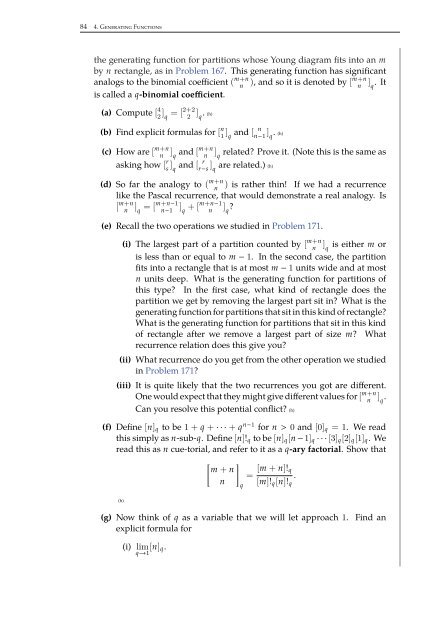Combinatorics Through Guided Discovery, 2004a
Combinatorics Through Guided Discovery, 2004a
Combinatorics Through Guided Discovery, 2004a
Create successful ePaper yourself
Turn your PDF publications into a flip-book with our unique Google optimized e-Paper software.
84 4. Generating Functions<br />
the generating function for partitions whose Young diagram fits into an m<br />
by n rectangle, as in Problem 167. This generating function has significant<br />
analogs to the binomial coefficient ( m+n<br />
n<br />
), and so it is denoted by [m+n n<br />
] q .It<br />
is called a q-binomial coefficient.<br />
(a) Compute [ 4 2 ] q = [2+2 2 ] q . (h)<br />
(b) Find explicit formulas for [ n 1 ] q and [ n<br />
n−1 ] q . (h)<br />
(c) How are [ m+n<br />
n<br />
] q<br />
asking how [ r s ] q and [ r<br />
r−s ] q<br />
and [m+n<br />
n<br />
] related? Prove it. (Note this is the same as<br />
q<br />
are related.) (h)<br />
(d) So far the analogy to ( m+n )<br />
n<br />
is rather thin! If we had a recurrence<br />
like the Pascal recurrence, that would demonstrate a real analogy. Is<br />
[ m+n<br />
n<br />
] q = [m+n−1 n−1<br />
] q + [m+n−1 ]<br />
n q<br />
?<br />
(e) Recall the two operations we studied in Problem 171.<br />
(i) The largest part of a partition counted by [ m+n<br />
n<br />
] is either m or<br />
q<br />
is less than or equal to m − 1. In the second case, the partition<br />
fits into a rectangle that is at most m − 1 units wide and at most<br />
n units deep. What is the generating function for partitions of<br />
this type? In the first case, what kind of rectangle does the<br />
partition we get by removing the largest part sit in? What is the<br />
generating function for partitions that sit in this kind of rectangle?<br />
What is the generating function for partitions that sit in this kind<br />
of rectangle after we remove a largest part of size m? What<br />
recurrence relation does this give you?<br />
(ii) What recurrence do you get from the other operation we studied<br />
in Problem 171?<br />
(iii) It is quite likely that the two recurrences you got are different.<br />
One would expect that they might give different values for [ m+n<br />
n ] q .<br />
Can you resolve this potential conflict? (h)<br />
(f) Define [n] q to be 1+q + ···+ q n−1 for n > 0 and [0] q =1. We read<br />
this simply as n-sub-q. Define [n]! q to be [n] q [n − 1] q ···[3] q [2] q [1] q .We<br />
read this as n cue-torial, and refer to it as a q-ary factorial. Show that<br />
[ ] m + n<br />
n<br />
q<br />
= [m + n]! q<br />
[m]! q [n]! q<br />
.<br />
(h)<br />
(g) Now think of q as a variable that we will let approach 1.<br />
explicit formula for<br />
Find an<br />
(i) <br />
q→1<br />
[n] q .


















